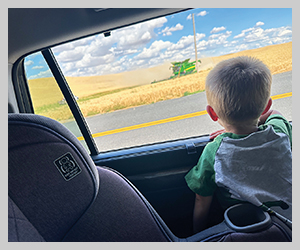
As winter settles in, most farmers’ fields go quiet, but that doesn’t mean nothing is happening.
In Eastern Washington’s Mediterranean climate, winter is when the region receives the majority of its precipitation, either as rain or, preferably, snow. Snow insulates crops from wind and excessively cold temperatures and allows soil microbes to stay active. Under the snow, winter wheat and other fall-planted crops are still alive. Nutrients from fall fertilizer applications, like nitrogen, are using winter precipitation to move through the soil down to where plants’ roots can access them. Residue left from the year’s crops is slowly breaking down, adding more nutrients back to the soil.
Inside, growers are using the time to catch up on bookkeeping and other paperwork. Many farmers will be finalizing taxes, preparing year-end reports, and working with government agencies to verify and finalize participation in farm service programs. Many growers also use the winter to take family vacations, attend conferences, and participate in grower educational opportunities. For industry commissions and associations, the start of a new year means legislative sessions, so growers who are active in those organizations will be spending time in state capitals or in Washington, D.C.
Work is also happening out in shops, where equipment is being taken apart, thoroughly cleaned, repaired if necessary, and re-assembled.
One of the most important tasks that farmers will undertake is to review their seeding, fertilizing, and harvest, looking at what worked and what didn’t work. When the crop was first planted, either in the previous fall or this spring, farmers had to make decisions on how much fertilizer to apply to maximize their yields without overspending on a very expensive input. Too little fertilizer, and the crop may not reach its yield potential, while too much fertilizer, besides being a waste of money, can actually hurt crops such as soft white wheat. Too much nitrogen increases protein in soft white wheat, which is supposed to be a low-protein crop. Growers will use soil tests to figure out how much nitrogen is already in the soil to help plan their fertilizer applications.
Most farmers don’t plant the same crop in the same field year after year. This crop rotation helps with weed management and improves soil health, and some crops, such as legumes, can actually add nitrogen back to the soil, giving the following crop a nutrient boost. Farmers will also be using information they’ve gathered from researchers, fields days, and summer crop tours to pick varieties to plant or to experiment with a new conservation or tillage practice.
Farmers in Eastern Washington have made huge strides in understanding soil health. They are experimenting with cover crops to help with nitrogen management and building soil organic matter, although cover crops may not be as effective in the dryer areas of the region. Direct seed and no-till cultivation methods have cut down on erosion, especially during winter thaw events.
Winter might look quiet, but dig a little deeper, and you’ll find farmers are as busy as ever.
This special section is a collaboration between the Washington Association of Wheat Growers and the Washington Grain Commission. Download a pdf of Seasons of Farming: Winter.
Other articles in the Seasons of Farming: Winter section:
Covering crop rotations: Many factors come into play when considering what to plant where
Nuts & bolts: Equipment work doesn’t stop when it’s cold; it just moves indoors












